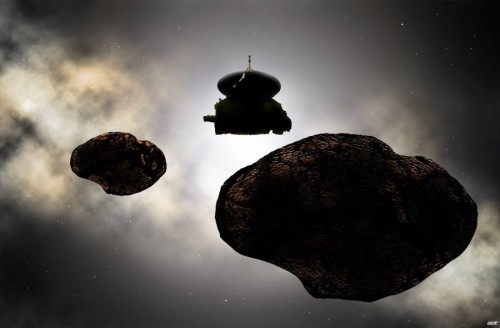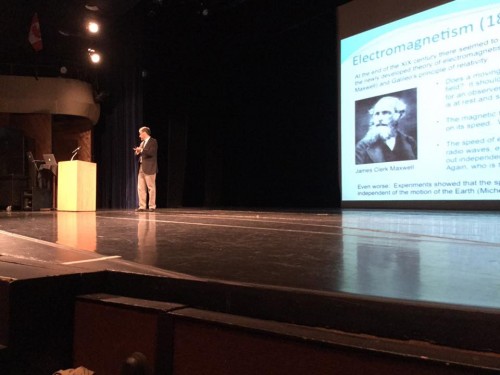Tag archives: astrophysics
Name a distant world, fireworks through a diffraction grating, radio telescope helps Puerto Rican relief

Double act: artist’s impression of the (486958) 2014 MU69 flyby. (Courtesy: NASA/Johns Hopkins University Applied Physics Laboratory/Southwest Research Institute/Carlos Hernandez)
By Hamish Johnston
Here is an opportunity to put your mark on the solar system. NASA and the team behind the New Horizons spacecraft are asking the public to nickname the mission’s next flyby target. Located in the Kuiper belt and called “(486958) 2014 MU69”, the target is likely to be two objects – each about 20 km across – in a very close orbit. So, a name like “Cheech and Chong” could be a winner. To enter, go to “Help us nickname a distant world”.
View all posts by this author | View this author's profile
Documentary explores the history of astronomy in China
By James Dacey
A new documentary explores the development of astronomy in China, taking viewers from the protoscience of ancient China through to the nation’s ambitious space exploration programmes of today. Directed by Beijing-based filmmaker René Seegers, the film has recently been broadcast on Shanghai Television along with screenings at a range of academic institutions, cultural and scholarly societies and embassies throughout China. Now, you can watch the film on the Physics World YouTube channel (with English subtitles).
“The Ancient Chinese believed that Heaven was a power, or a deity, which judged humans. Heaven was responsible for weather and for natural disasters. It was not a realm accessible to humans,” explains Ying Da, the documentary’s presenter. Ying is a media personality who shot to fame in China for directing the family sitcom I Love My Family (1993–1994).
Of course, in recent times Chinese scientists and engineers have taken a much more proactive approach to understanding the cosmos. Since the People’s Republic of China launched its first satellite in 1970 (Dong Fang Hong I), the nation has been ramping up its space programmes. The documentary takes viewers to observatories and the final construction phase of the Five-hundred-meter Aperture Spherical Telescope (FAST), the largest single-dish radio telescope on Earth. It also joins Chinese scientists in Antarctica and explores the leading role China is playing in the construction and operation of the Thirty Meter Telescope in Hawaii.
View all posts by this author | View this author's profile
Create films with the sounds of space
By James Dacey
Last weekend I went to a Davie Bowie tribute night at a local pub in Bath. It was a fun evening – roughly a year since the artist passed away – where local musicians played classic tracks by Ziggy Stardust, the Thin White Duke and several of Bowie’s other alter egos. One of the more surreal moments of the night was when a man in a pink suit took to the stage to play what the band called his “spaceship” – producing a whirring, repetitive electronic sound that built up to a crescendo. For a few minutes we were transported into space, just as Bowie intended with many of his memorable songs.
View all posts by this author | View this author's profile
Physics World 2015 Focus on Astronomy and Space is out now
By Louise Mayor
 Woolly hats are being donned and there’s a nip in the air as the longest night of the year in the Northern hemisphere approaches. All this darkness makes it the perfect season to gaze up at the stars, planets and puffy nebulae above. But binoculars and amateur telescopes can only enhance the view by so much. To really push the boundaries of how far and how fine we can see, we must turn to international telescope projects both on the ground and in space.
Woolly hats are being donned and there’s a nip in the air as the longest night of the year in the Northern hemisphere approaches. All this darkness makes it the perfect season to gaze up at the stars, planets and puffy nebulae above. But binoculars and amateur telescopes can only enhance the view by so much. To really push the boundaries of how far and how fine we can see, we must turn to international telescope projects both on the ground and in space.
To update you on what we think are the most exciting current and future projects we bring you the Physics World Focus on Astronomy and Space, which you can read free of charge in its entirety.
One particularly ambitious imaging effort is described in the article “Portrait of a black hole“, in which Physics World reporter Tushna Commissariat reports on how a group of astronomers plans to take the first-ever image of a black hole. Despite their name, black holes are apparently not black and the Event Horizon Telescope collaboration has already begun pointing a network of ground-based telescopes at its target: Sagittarius A*, the supermassive black hole at the centre of our galaxy.
View all posts by this author | View this author's profile
Physics World special report on Mexico is out now
By James Dacey
Today is Mexico’s Independence Day, marking the Grito de Dolores – the day in 1810 when the Roman Catholic priest Miguel Hidalgo called on his congregation in the small Mexican town of Dolores to revolt against the Spanish colonial government. This “Cry of Dolores” is seen as the flash point that triggered the Mexican War of Independence.
Modern-day Mexico is still a place with its fair share of turmoil, as the government faces increasing pressure over its inability to deal with drugs, violence and corruption. One area that is starting to look more positive, however, is Mexico’s science base – the administration of president Enrique Peña Nieto has vowed to double Mexico’s investment in science and technology to 1% of GDP and has already sanctioned increases in 2013 and 2014.
To shine a light on what the Mexican physics community is up to, this month sees the publication of a new free-to-read Physics World special report on physics in Mexico. We believe that physicists in Mexico are doing engaging work that deserves to be more widely known. In choosing our coverage for the report, we have not only focused on the challenges for the Mexican community, but also hope to give you a flavour of the rich culture and geography of this most colourful of countries.
The Magnus effect in action, destroying the world, an astrophysicist camps out in Manchester and more
By Hamish Johnston and Michael Banks
This week’s Red Folder opens with a fantastic video (above) from the folks at Veritasium. It involves dropping a spinning basketball from the top of a very tall dam in Tasmania and watching as the ball accelerates away from the face of the dam before bouncing across the surface of the water below. In comparison, a non-spinning ball simply falls straight down. This happens because of the Magnus effect, which has also been used to create flying machines and sail-free wind-powered boats. The effect also plays an important role in ball sports such as tennis and is explained in much more detail in our article “The physics of football”.
Rachid Ouyed talks about quark novae and the quark stars they could produce
By Hamish Johnston
Recently I blogged about quark novae, which are a passion of the University of Calgary astrophysicist Rachid Ouyed. I caught up with Ouyed at the Canadian Association of Physicists Congress in Edmonton last month, where between sessions he was busy writing a paper about quark novae.
I managed to coax him away from his calculations for long enough to record the above video, in which he talks about quark novae – huge explosions that some astrophysicists believe could occur shortly after some supernovae. Ouyed also talks about the quark stars that may be left behind and how quark novae could affect how astronomers measure cosmological distances.
View all posts by this author | View this author's profile
Debating warp bubbles and quark novae over beer and samosas

Time traveller: Miguel Alcubierre works the crowd in Edmonton.
By Hamish Johnston at the CAP Congress in Edmonton, Canada
The first day of the Canadian Association of Physicists (CAP) Congress at the University of Edmonton closed yesterday on the theme of time travel. Surely that is science fiction, you are thinking? But Miguel Alcubierre of the National Autonomous University of Mexico (UNAM) wasn’t joking when he delivered the Herzberg Memorial Lecture yesterday evening (although he did giggle a lot during his talk, which was very endearing). The session was called “Faster than the speed of light” and it was a fascinating romp through some of the more bizarre implications of Einstein’s general theory of relativity (GR) – which is 100 years old this year.
View all posts by this author | View this author's profile
On top of the volcano – part two
By Matin Durrani at Sierra Negra, Mexico
Just as my Physics World colleague James Dacey mentioned earlier, neither of us felt super-wonderful yesterday visiting the Large Millimeter Telescope (LMT), which sits at a height of 4600 metres above sea level. Spectacular though the facility is, the air pressure is roughly 60% of that at sea level and there is so little oxygen that even walking up a flight of stairs made me feeling pretty light-headed.
So, James and I were both quite glad to descend with LMT director David H Hughes to a height of 4100 metres, where it was time to visit another leading Mexican astronomy facility – the High-Altitude Water Cherenkov (HAWC) gamma-ray observatory.
View all posts by this author | View this author's profile
On top of the volcano – part one
By James Dacey at Sierra Negra, Mexico
Friday was the final full day of the Physics World Mexican adventure and we ended with a breathtaking experience, quite literally.
Matin and I rose early in Puebla to travel over a hundred kilometres east to the ominously named Sierra Negra volcano. This extinct beast is home to two of Mexico’s finest astrophysics facilities.
View all posts by this author | View this author's profile